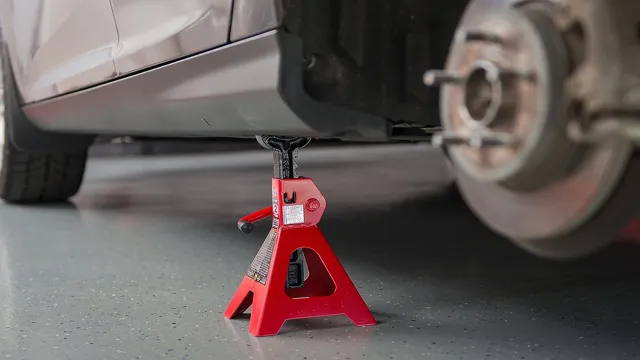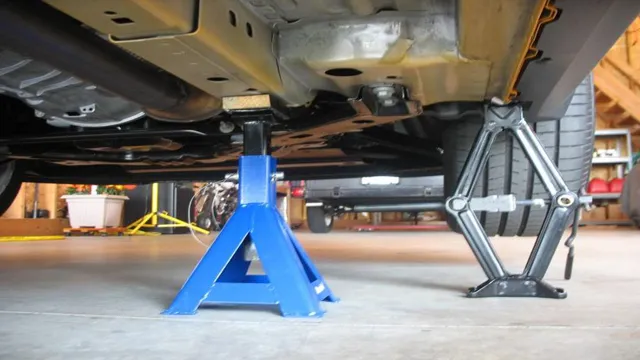How to Set Up Jack Stands: A Step-By-Step Guide for Safe Vehicle Lifting

If you’re a DIYer or work on your car in any capacity, you know the importance of having a good set of jack stands when it comes to raising your vehicle off the ground. However, it’s equally essential to know how to set them up safely to avoid accidents or injuries to yourself and others. Setting up jack stands can be a daunting task, especially if you’re a beginner, but it doesn’t have to be.
With a little bit of knowledge and precaution, you can set up your jack stands without any issues. In this blog post, we’ll go over everything you need to know about how to set up jack stands safely and what to look out for to prevent any mishaps. So, let’s dive in and make sure you’re properly supporting your car while you work on it!
Choose the Right Jack Stands
When it comes to working on your car, safety should always be your top priority. One critical aspect of car maintenance is to elevate your vehicle using a jack stand. Knowing how to set up jack stands is essential in preventing accidents caused by the car falling on you.
The first step is to choose the right jack stand that can support the weight of your vehicle. Before buying jack stands, check your vehicle’s owner’s manual and find out how heavy it is. Be sure to get a jack stand that can support at least this weight.
Additionally, you need to ensure that the jack stands have a sturdy base and a locking mechanism to prevent the car from slipping off. Once you’ve chosen the right jack stands, place them under the designated jacking points on your car. Make sure they are securely locked in place before removing the jack.
Remember to never work under your car without jack stands securely in place. By following these simple steps, you can safely elevate your vehicle and perform necessary maintenance tasks.
Check Their Weight Capacity
When it comes to choosing the right jack stands, weight capacity is a crucial factor that should never be overlooked. Before you make a purchase, it’s important to consider the weight of your vehicle and ensure that the jack stands you select can support it safely and securely. If you’re not sure about the weight capacity, consulting your vehicle’s owner’s manual or checking with the manufacturer can provide you with the necessary information to make an informed decision.
Using jack stands with a weight capacity that isn’t sufficient for your vehicle can be dangerous, and it’s simply not worth taking the risk. By prioritizing weight capacity as you shop for jack stands, you can ensure your safety and the safety of those around you.

Select the Correct Height
When it comes to choosing the right jack stands for your vehicle, one of the most critical considerations is selecting the correct height. You want to ensure that the jack stands you select have a height that is suitable for your vehicle and will adequately support it while it’s elevated. The easiest way to determine the correct height for your jack stands is by consulting your vehicle owner’s manual.
It will provide you with information on the weight and height of your vehicle and specify the height required for your jack stands. Alternatively, you can measure the distance from the ground to the vehicle’s jacking point to get an accurate height measurement. Remember to always choose a jack stand that exceeds your vehicle’s weight and height requirements to ensure maximum safety.
Don’t risk your safety by using poorly chosen jack stands; take a few extra minutes to research and select the perfect ones for your vehicle.
Prepare Your Vehicle
Setting up jack stands can seem like a daunting task, especially if you haven’t done it before. However, it’s essential to ensure your safety when working underneath your vehicle. First, make sure you’re parked on a level surface and engage the emergency brake.
Then, locate the car’s recommended jacking points, usually found in the owner’s manual. Next, place the jack stand on a firm and level surface underneath the recommended jacking point and adjust the height to match your vehicle’s position. Ensure that the jack stand is securely in place and that it won’t tip over easily.
Lastly, test the stability of the vehicle by giving it a gentle push before getting to work underneath it. By setting up jack stands properly, you can safely do maintenance on your vehicle without any risks.
Park on a Flat Surface
When parking your car, it’s important to make sure that it’s on a flat surface. This can help to prevent the vehicle from rolling or tipping over, which could cause significant damage, injuries, or even fatalities. Before you park, take a moment to survey the area and look for a flat spot to park.
If you don’t see any suitable spots, consider finding a different location to park. Once you’ve found a flat surface, prepare your vehicle by placing it into park (if it’s an automatic) or into gear (if it’s a manual). If your car has a parking brake, engage it to provide an extra layer of security.
By taking these steps, you’ll help to ensure that your vehicle stays put and that it’s safe for you and others to be around.
Engage the Parking Brake
When preparing your vehicle for parking, it is essential to engage the parking brake before exiting. This simple step can prevent your vehicle from rolling away and causing unnecessary damage. The parking brake, also known as the handbrake, is located next to the driver’s seat and is often activated by pulling up a lever or pushing a button.
Once engaged, it locks the rear wheels in place, adding an extra layer of security to your vehicle. It is important to note that the parking brake should be used even when parking on a flat surface. In the case of a incline, using the parking brake becomes even more critical.
So, be sure to get in the habit of engaging your parking brake every time you park your vehicle to ensure both your safety and the safety of others.
Chock the Wheels
“Chock the Wheels” Before hitting the road, it’s always important to prepare your vehicle for a safe and smooth journey. A crucial step in this preparation process is to chock the wheels. Chocking the wheels is simply placing a wedge or block behind the wheels to prevent the vehicle from moving while parked.
This is especially important when parking on an incline, as the vehicle can roll away and cause damage or accidents. Chocking the wheels can also prevent the vehicle from accidentally shifting out of park and causing harm. It is recommended to use wheel chocks that are appropriate for the weight and size of your vehicle.
By taking this simple precaution, you can ensure a more secure and safer parking experience for yourself and those around you. So don’t forget to chock the wheels before you go on your next road trip. It could make all the difference in the world.
Setting Up the Jack Stands
Learning how to set up jack stands is a critical piece of knowledge for anyone who may need to work on their car or conduct maintenance at home. To begin, locate a level surface, then place the jack on the designated jacking point on your vehicle’s chassis. Once the car is securely elevated, locate the jack stand’s point of contact in the owner’s manual.
Place the jack stand below the recommended spot and raise it until it’s flush with the jack point. Ensure the stand is perpendicular to the ground and in line with the chassis. Slowly lower the car onto the jack stand, then double-check that the stand is securely in place before removing the jack.
Repeat the process on the opposite side of the vehicle until both sides are securely lifted. By properly setting up jack stands, you can work on your vehicle with added safety and confidence.
Locate Jack Points
When it’s time to perform some maintenance on your car or change a flat tire, using a jack stand is essential for your safety. But before you even consider jacking up your car, you should locate the appropriate jack points. These are the spots on your car’s frame that are sturdy enough to hold the weight of the car without getting damaged.
Look at your car’s manual to find out where these points are, as they can differ depending on your vehicle’s make and model. Once you have identified the jack points, you’re ready to set up the jack stands. Make sure that you choose a flat and level surface, as this will allow you to appropriately place the base of the jack stand.
Always position the jack stands at the exact same height and on the identical spots on both sides of your car to evenly distribute weight and prevent any instability. Following these steps will ensure that your car is securely lifted, which is essential for your safety and the safety of others.
Place Jack Stands Securely
When it comes to working on your car, safety should always be your top priority. One important step in ensuring safety is setting up your jack stands securely. Before getting started, make sure you choose a level surface to work on.
Then, position your jack stands at the correct points under your vehicle’s chassis. To do this, consult your owner’s manual or do some research online to find the proper placement based on your car’s make and model. Once you’ve positioned your jack stands, make sure they’re locked in place and stable.
Give your car a gentle push to test the stability, and adjust the positioning if necessary. Remember, your jack stands are essential for keeping you and your car safe while working underneath it, so take the time to do it right.
Lower Your Vehicle Onto the Stands
Setting up the jack stands is the next step in lowering your vehicle safely. Start by selecting an appropriate location for the stands, which should be on a flat and stable surface. Then, position the stands under the vehicle’s recommended support points, such as the frame or the specified jacking points.
The stands should be placed at an equal distance from the vehicle and adjusted to match its height. As you lower the vehicle onto the stands, make sure that the stands are positioned securely and that the vehicle is centered on top of them. Finally, double-check that the stands are level and tightened properly before getting started in working on your vehicle.
Remember that safety is crucial when using jack stands, so never compromise on the quality or stability of your equipment. By following these steps, you can be assured that your vehicle is safely supported and ready for any maintenance or repair job.
Double Check Your Work
Setting up jack stands is a crucial task that requires attention to detail and carefulness. First, ensure your car is on a flat and stable surface and that the emergency brake is engaged. Next, identify the jack points of your vehicle, which can usually be found in your owner’s manual.
Once you’ve raised the car with a floor jack, slide the jack stand underneath the car’s jack point and ensure it is securely placed on the stand’s saddle. Repeat the process for each of the jack points, making sure that the stands are level and the weight is evenly distributed. Remember to double-check your work before getting under the car to ensure your safety.
It’s always better to be safe than sorry, so take your time and double-check before you start working under your vehicle. By following these steps carefully, you can set up your jack stands safely and with confidence.
Conclusion
Setting up jack stands may seem like a daunting task, but with a little know-how and some elbow grease, you’ll be lifting your car like a pro! Remember to always use quality jack stands, position them on a flat surface, and double-check that they’re secure before crawling underneath your vehicle. And if you’re feeling unsure or unsure about any of the steps, don’t be afraid to ask for help – safety always comes first. So go forth, fellow gearheads, and set up those jack stands with confidence and finesse – your car (and your life) will thank you!”
FAQs
What size jack stands should I use for my vehicle?
The size of jack stands you should use depends on the weight of your vehicle. Refer to your vehicle’s manual or consult a professional for the appropriate size.
Can I use jack stands on uneven ground?
No, it is not recommended to use jack stands on uneven ground as they may tip over and cause damage. Find a level surface to use jack stands on.
How do I properly place jack stands under my vehicle?
Make sure the vehicle is on level ground and the emergency brake is engaged. Always place the jack stands on a solid part of the vehicle’s frame and never on the suspension or body panels.
Should I use jack stands on a lifted vehicle?
Yes, it is important to use jack stands even on a lifted vehicle to ensure safety and stability.
How many jack stands do I need to use?
Two jack stands are typically needed to support the weight of the vehicle. Make sure they are placed on opposite sides of each other.
Can I use homemade jack stands?
No, it is not recommended to use homemade jack stands as they may not be stable or strong enough to support the weight of the vehicle.
When should I replace my jack stands?
It is recommended to replace jack stands every 2-3 years or if they show signs of damage or wear. Always inspect them before use.



